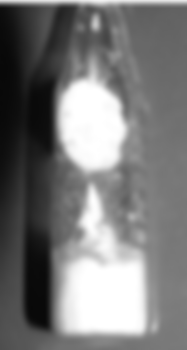COLLAPSE
Cause: It is a phenomenon which occurs in amorphous solids when the product reaches a higher temperature than the collapse temperature, Tc (closer to the glass transition temperature Tg’). The amorphous phase of the solid experiences internal movement without reaching the melting point, with the crumbling or collapse of the dried cake as a result.
Solution: Maintain the product temperature below the collapse temperature during all the primary drying time (while there is still presence of ice in the product). Avoid the formation of a “dried skin” at the top of the surface.

MELTBACK
Cause: It happens when the primary drying phase has ended but some of the vials still have some ice at the bottom. During the secondary drying, the remaining ice is not removed. When the process finished and such ice has not been removed properly it melts and wets the dried product forming some cavities.
Solution: Set a longer primary drying. Increase the security time between the primary drying and the secondary drying.

DROPS ON THE VIAL WALL
Cause: It happens in eutectic and viscous products, when the primary drying is started, some parts of not frozen product from the top layer boil, explode and get stuck to the internal lateral walls of the vial, which are at a lower temperature than the product.
Solution: Add an annealing step with thermal treatment. To use substances which prevent the migration of product to the top layer.

DETACHED CAKE
Cause: When the concentration of solids in the product’s solution is low, a reduction of the lyophilized mass may occur, with the consequence of the cake detaching itself from the walls remaining free inside the vial with the possibility of suffering some breaking.
Solution: Increase the concentration of substance, concentration of solids, in order to obtain a more consistent cake.

INCONSISTENT MASS
Cause: It happens when the concentration of product is too low or the product has undergone a really fast freezing step with products containing a low concentration of substances such as manitol.
Solution: Perform a freezing step adding a previous nucleation step at ~2ºC or an annealing step with thermal treatment. Also, increase the concentration of substance.

CAKE SHRINKAGE
Cause: If a lyophilization cycle is finished but the product still has a high percentage of residual moisture or if the vials are stoppered with humid air inside, the cake may suffer some shrinkage as it absorbs the ambient from the vial’s atmosphere.
Solution: Make sure the drying phases of the cycle have properly finished. Break the existing vacuum in the chamber with dry nitrogen gas.

PUFFING (TOTAL BOILING)
Cause: Appliance of excessive heat triggers the spontaneous melting of the product. The product may end up outside the vial. It may also happen because of a vial being stoppered at the beginning of the cycle by error.
Solution: Reduce the heat input during the first phases of the primary drying, increasing the time of the step. Also, controlling the vacuum level.

RIGID AND IMPERMEABLE TOP LAYER
Cause: When micro-boiling of the top layer occurs, forming an impermeable skin which hinders the path for the sublimated vapor flow. Its root cause is insufficient freezing, with a spontaneous concentration of product at the top layer because of the effect of cryo-concentration or due to slow evacuation of the chamber during the vacuum phase.
Solution: Properly freezing with a high cooling rate. Evacuate the chamber as quick as possible. Perform a primary drying step with low temperature and sublimation rate to allow the water vapor to escape through the formed skin.

BREAKAGE OF THE BOTTOM OF THE VIAL
Cause: A re-crystallization occurs during the freezing step, mainly in amorphous products. The cake suffers an increase in volume. In concentrated solutions, the pressure of the vapor at the bottom of the vial may rise in case of applying too much energy to the product at the beginning of the primary drying.
Solution: Cool down the product and slowly freeze it to enhance the formation of larger and dendritic ice crystals or add an annealing step with thermal treatment with a slow cooling at the end. Start the primary drying with a smooth application of heat, to facilitate the exit of the water vapor through the lateral walls of the vial. Add a little fraction of alcohol. Use thicker vials or vials of more quality.